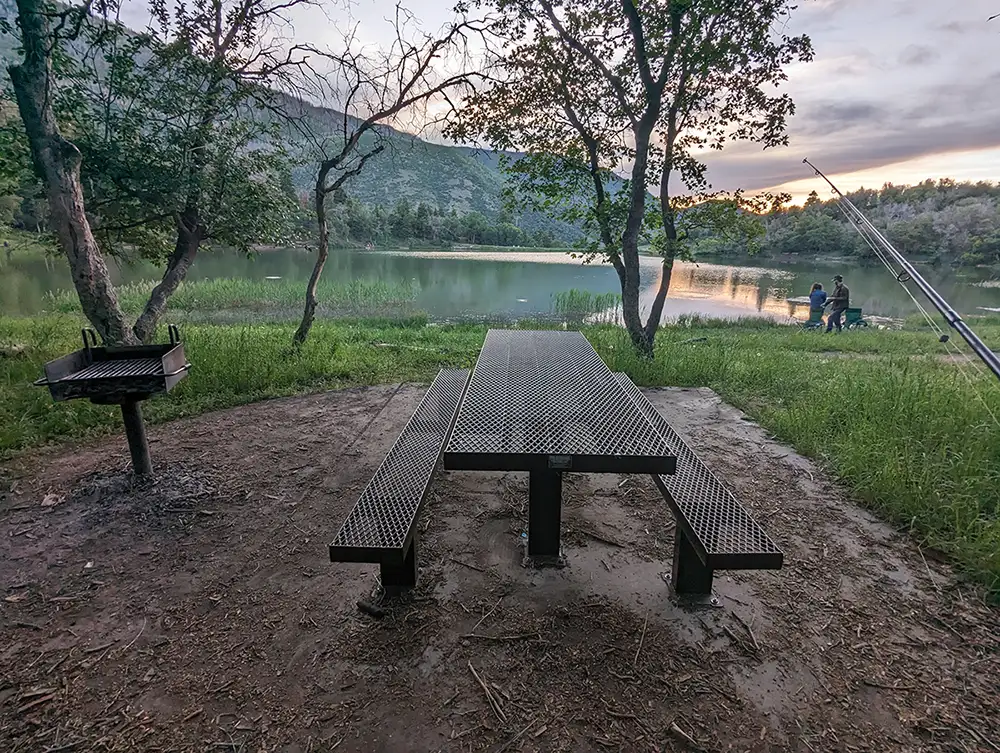Directions
Maple Lake is located in Utah County, Utah. From Payson, head up Payson Canyon on the Nebo Loop Road for about 5.5 miles. There will be a sign for Maple Lake Campground and or Maple Bench Campground. Turn onto S Maple Lake Rd / FR 020. Follow this road about 1.3 miles. The road will end in a loop.
You can park by the restrooms at the loop and follow the many trails for about 25 feet to the lake. Or you can take the turn off just before the loop and park near the Vault Toilets campgrounds. This is also where the trail head for Red Lake is at. There are several trails in this area that lead down to Maple Lake as well.
Fish Species
Most likely catch is gold fish and or rainbow trout.
Possible catch is tiger muskie, tiger trout, brook trout, and wiper.
Around 2014 someone illegally introduced gold fish into the lake. The Lake was treated in 2018, but the goldfish didn't die off. So now the DWR is trying to manage the population with predator fish.
Other Info
There is a path around the lake that is pretty easy for smaller children to walk on.
Here is a video of a guy riding a wheelie on his bike near the lake.
Camping
There is multiple camping spots that are within walking distance of the lake. When I was last here in 2024 there was a cash only pay station. The cost was $27 a night for camping and $10 for a day pass. You will need exact change.
There are no trailers allowed in the canyon. Tent camping only.
There is two main campsite. Maple Lake campground and Maple Bench Campground.
Nearby Areas to Fish
Scout Lake, Dry Lake Reservoir, Red Lake, Pete Winward Reservoir, McClellan Lake, Box Lake, Big East Reservoir, and Salem Lake.
History
Late 1800's. A. M. Musser Utah's fish commissioner plants black bass in Maple Lake.
1922. 100,000 rainbow trout are planted by Dr. L.N. Ellsworth and J.C. Townsend owner of the Payson beauty spot up the canyon.
1927. Payson Fish and game association to meet with city council to see about taking over Maple Lake, which if properly drained and cared for, would make an excellent place for fish.
1933. Four beavers are planted in the canyon in effort to start a population.
1934. It is proposed that Maple Lake should be turned into a fishery.
1925. Work to raise dam 15 feet higher. This will increase the amount of water by 150,000 acre feet. Which was four times capacity. The hope is to make the resevoir a permanent fishing resort. The project is funded by Payson and City. Employment on the project is given in exchange for water rights. This makes the expenses of the project much less than estimated.
1941. Payson Wildlife Federation a group of volunteers from Payson, Eureka, Dividend, Goshen, Santaquin, Spring Lake and Benjamin. clears the road so that the lake can be planted.
1941. 1,500 spawners, legal sized trout planted. Small chubs are numbered in the thousands. The hope is the legal size trout will eat the chub.
1955. Dam repaired and raised.
1958. Forest Service proposes $36,000 to build 45 family picnic areas.
1961. Lake treated with Rotenone on 9/14/61. No game fish were found in the water. Only carp, perch and chubs were found.
1961. An increase in storage capacity is planned.
1962. Plans to develop a paved road to the lake and sanitary toilets.
1964. A rainbow trout measuring 18 inches is caught in the lake, which makes the newspaper.
1965. First record I could find of nearby Red Lake being stocked.
1965 A 3 and 1/2 pound rainbow trout is caught by a 9 year old.
1967. Karen Davis catches a 23" rainbow weighing 5 and 1/2 pounds.
1968. A gate is installed to close the road in winter until the snow has melted. People traveling up the road in the early spring snowy mud are doing extensive damge. The gate is sought to keep repair costs of the road down.
1968. Good sized brown trout and rainbow trout up to 2 pounds are reported. Red Lake rainbows are reported to be from 10 to 12".
1968. 600 seat ampitheater at nearby Camp maple Dell is dedicated.
1969/70. Reports of good fishing for browns, brook, rainbow and bluegill.
1971. The lake is treated with Rotenone to remove bluegill.
1973. Flooding causes dam to break at nearby Box Reservoir which causes extensive damage to the road.
1973. Planted with brook trout fingerlings via airplane due to road issues.
1977. Drained for dam repair and treated with Rotenone to remove overpopulation of sunfish. The sunfish don't compete with the rainbows for food. There is plenty of food. The green sunfish were so numerous you could catch one with every catch.
1983. Good sized brook trout being reported.
1993. Construction of two toilets and a parking area.
2015. Reports of goldfish population.
2018. DWR treats the Lake with Rotenone to remove the goldfish. The treatment either fails of the fish is reintroduced.
2019. Tiger trout and wiper are planted in hopes they will consume the goldfish.
2020. Tiger muskie and wiper is planted in hopes more predator fish will take out the goldfish.

